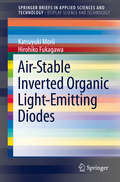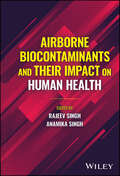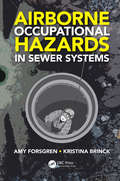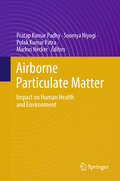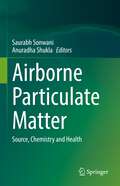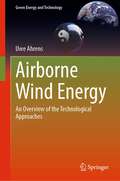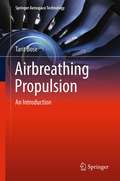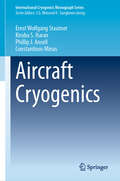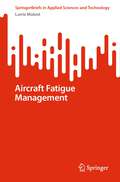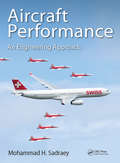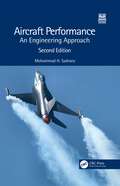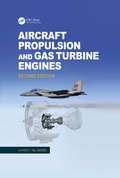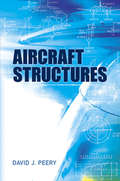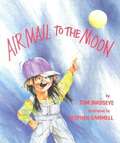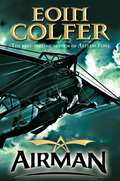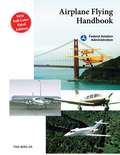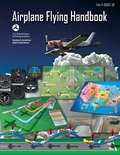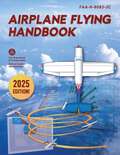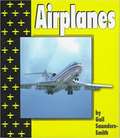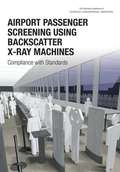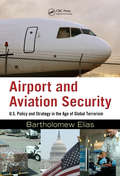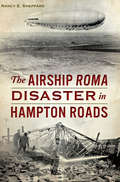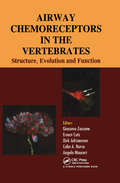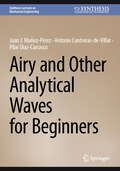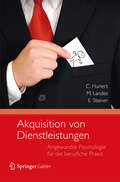- Table View
- List View
Air-Stable Inverted Organic Light-Emitting Diodes (SpringerBriefs in Applied Sciences and Technology)
by Katsuyuki Morii Hirohiko FukagawaThis concise volume provides an introduction to the working principles, design, and construction of air-stable inverted organic light-emitting diodes (OLEDs), which lead to the realization of practical flexible electronics. The first part of the book reviews the history of the three generations of inverted OLEDs: hybrid organic inorganic light-emitting diodes (HOILEDs), metal oxides and organic electron injection layer, describing the materials, fabrication techniques, device structure, applications, and technological challenges involved in each case. The second part of the book focuses on the carrier injection mechanism in OLEDs.The book will be of interest to students and researchers working on organic optoelectronics.
Airborne Biocontaminants and their Impact on Human Health
by Rajeev Singh Anamika SinghExplore in-depth the relationships between biological contaminants and human health found in diverse settings such as homes, hospitals, businesses, and schools Indoor air quality has an immense impact on human health and well-being. Indoor air environments can contain a huge range of biological contaminants, including bacteria, fungi, viruses, insects, and their various harmful byproducts. Indoor biocontamination has been under-studied as an aspect of public and occupational health, and there is an urgent need for an introduction to this vital subject. Airborne Biocontaminants and Their Impact on Human Health meets this need with a thorough, rigorous overview of major indoor airborne contaminants. Gathering and summarizing a huge range of data regarding biocontaminants in settings from homes to schools to workplaces, it investigates patterns of morbidity and their connections to major contaminants. The result is an essential tool in the broader fight for human health at home and elsewhere. Airborne Biocontaminants and Their Impact on Human Health readers will also find: Analysis of the indoor role of gases, particulate matter, and others Detailed coverage of contaminant byproducts including endotoxins, mycotoxins, volatile organic compounds, and more Methods for generating awareness and therefore reduced risk of exposure to harmful contaminants Airborne Biocontaminants and Their Impact on Human Health is ideal for researchers—biologists, environmentalists, civil and environmental engineers, industrial hygienists, safety regulators, and public health officials—interested in the area of biological contamination in different environments.
Airborne Occupational Hazards in Sewer Systems
by Amy Forsgren Kristina BrinckSewer systems fall into the category "out of sight, out of mind" – they seldom excite interest. But when things go wrong with the air in the sewer system, they go very wrong. Consequences can be dramatic and devastating: sewer workers killed instantly by poisonous gas when they lift a sewer lid, or entire suburban blocks levelled by explosions. This book describes the atmospheric dangers commonly found in the sewer system. It provides easily-understood explanations of the science behind the hazards, combined with real-life examples of when things went dramatically wrong.
Airborne Particulate Matter: Impact on Human Health and Environment
by Markus Hecker Pratap Kumar Padhy Soumya Niyogi Pulak Kumar PatraParticulate matter (PM) in the ambient air is a key indicator of air pollution. It can be suspended over long time and travel over a long distance in the atmosphere. It can cause a wide range of diseases that lead to a significant reduction of human life. Because of the potent role of PM and its associated pollutants, detailed knowledge of their effects on the environment in general, and human health in particular, is of primary importance. This book provides an in-depth overview of monitoring of airborne particulates and their sources and transport. The dynamics of nutrients, intake pathways of particulates by human body and other components of environment, and their possible health hazards and effects at different levels and at various organs are discussed. With contributions from well-known experts from diverse research fields, including medical and public health science professions, this book provides an exhaustive information on the health risks of air pollution and explores its control and mitigation strategies. In addition to providing a scientific basis for particulate air pollution, this book will also help readers, researchers and public health professionals to appreciate the environmental determinants of public health and apply research evidence for improving the quality of life. This will also delineate future research initiatives and policy actions needed with more stringent strategies for protecting the environment in general and human health in particular from PM at local, regional, and global levels.
Airborne Particulate Matter: Source, Chemistry and Health
by Anuradha Shukla Saurabh SonwaniThis book is about airborne particulate matter, sources, chemistry and health and contained a complete information about their emission source, transport, atmospheric chemistry, distribution at local, regional and global levels, and their level in indoor and outdoor settings. Primary and secondary particulate matters in the ambient atmosphere also describe in detail. Analytical techniques, statistical tools and mathematical models used in airborne particulate research is also described. This book also covers the important aspects of the particulate matter chemistry in atmosphere, and their adverse impact on plant and human health. A detailed insight about the harmful impact of airborne particulate matter (biogenic and anthropogenic both) on different human system is described in detail. The toxicological significance of particulate matter on human body was also mentioned. The mitigation, management and regulatory policies to control ambient particulate matter is also provided. This book is also written in simple language with helpful photographs, diagrams, tables and flowcharts which will make the reader comfortable in understanding the concepts a more relatively easier way. Overall, the present book is a valuable tool for students working in the fields of Atmospheric Science, Environmental Science, Biological Sciences, Epidemiology and Agriculture Science. This book also a unique resource for environmental consultants, researchers, policymakers and other professionals involved in air quality, plant and human health.
Airborne Wind Energy: An Overview of the Technological Approaches (Green Energy and Technology)
by Uwe AhrensThis book shows possible solutions to how a profitable energy supply can be implemented with almost no population resistance. Worldwide, more than 80 % of our energy needs are still covered by fossil fuels. Under these circumstances, can climate change still be stopped? Essential technologies for usage of wind energy with an emphasis on high-altitude wind utilization are presented. Airborne wind energy is one of the most promising technologies to enable a renewable energy turnaround in an economical way. The main problem of conventional renewable energy is the insufficient availability. To ensure a 100 % supply of renewable energy, enormous and very expensive storage capacities would have to be built up. How we can cover our entire energy needs (electricity, mobility and heat) in the future without fossil fuels, without risking the competitiveness of our economy, is shown in this book.
Airbreathing Propulsion: An Introduction (Springer Aerospace Technology)
by Tarit BoseAirbreathing Propulsion covers the physics of combustion, fluid and thermo-dynamics, and structural mechanics of airbreathing engines, including piston, turboprop, turbojet, turbofan, and ramjet engines. End-of-chapter exercises allow the reader to practice the fundamental concepts behind airbreathing propulsion, and the included PAGIC computer code will help the reader to examine the relationships between the performance parameters of different engines. Large amounts of data have on many different piston, turbojet, and turboprop engines have been compiled for this book and are included as an appendix. This textbook is ideal for senior undergraduate and graduate students studying aeronautical engineering, aerospace engineering, and mechanical engineering.
Aircraft Cryogenics (International Cryogenics Monograph Series)
by Ernst Wolfgang Stautner Kiruba S. Haran Phillip J. Ansell Constantinos MinasThis book gives a step-by-step approach to the design of a cryogenic infrastructure required for superconducting, all-electric aircraft systems which is also partially applicable to liquid hydrogen fueled subsonic and hypersonic aircraft, as well as hybrids. While there is no shortage of publications on hydrogen fueled aircraft, this book puts the past journal literature through a magnifying glass and condenses it into an engineering strategy for the next steps to enable liquid hydrogen storage and distribution in aircraft. Emphasis is placed on tank design, manufacturability, safety features, and minimum tank weight, providing a holistic focus on the logistics of hydrogen management for all major components within the aircraft as well as on future superconducting motor architecture. The intention is to fully exploit the benefits of a liquid hydrogen reservoir without any need for additional cryogenic fluids, with relevance to cooling of various superconducting components e.g., motors and superconducting cables, as well as the heat sinking of power electronics and for fueling the fuel cell stack system. A liquid hydrogen tank hold-time analysis reveals the main governing factors and describes the required efforts for minimizing onboard boil off for aircraft designs with different flight mission duration. This is followed by an outlook showing where cryotankage technology and cryogenic aircraft architecture may move within the next 20 years embedded in a green hydrogen-based economy and how basic research will need to play a major role to help us realizing these future designs by consequently eliminating whitespace within today's technology landscape. This book is also an aircraft engineering resource on composites, hydrogen properties, general aircraft materials and safety.
Aircraft Fatigue Management (SpringerBriefs in Applied Sciences and Technology)
by Lorrie MolentFatigue occurs under cyclic loading and can significantly degrade the operational capability and safety of metallic aircraft components and structures. This book provides summaries of some metallic aircraft structural integrity issues, innovative but established examples of maintaining operational capability—airworthiness, and assessments of safe in-service fatigue lives. These topics are based on a through-life fatigue management philosophy that ensures safe and continued operation, including during life extensions that are almost inevitably required. This philosophy is underpinned by observations of the behaviour of fatigue cracks in actual structures subjected to realistic service loading conditions. The book includes topics like aircraft design requirements, individual aircraft fatigue loads monitoring, airframe fatigue testing, sources of fatigue-nucleating discontinuities, and prediction of fatigue crack growth from these discontinuities. All these aspects contribute to discussing methods of assuring the structural integrity and operational capability of realistically cracked structures. The book also discusses the exponential behaviour of lead or dominant cracks—those leading to first failure—and the practical significance of differences between fatigue fracture topographies produced under constant amplitude and variable amplitude loading. The book can be a valuable reference for researchers and professionals interested in aircraft fatigue management and allied fields.
Aircraft Performance: An Engineering Approach
by Mohammad H. SadraeyAircraft Performance: An Engineering Approach introduces flight performance analysis techniques that enable readers to determine performance and flight capabilities of aircraft. Flight performance analysis for prop-driven and jet aircraft is explored, supported by examples and illustrations, many in full color. MATLAB programming for performance analysis is included, and coverage of modern aircraft types is emphasized. The text builds a strong foundation for advanced coursework in aircraft design and performance analysis.
Aircraft Performance: An Engineering Approach
by Mohammad H. SadraeyAircraft Performance: An Engineering Approach, Second Edition introduces flight performance analysis techniques of fixed-wing air vehicles, particularly heavier-than-aircraft. It covers maximum speed, absolute ceiling, rate of climb, range, endurance, turn performance, and takeoff run.Enabling the reader to analyze the performance and flight capabilities of an aircraft by utilizing only the aircraft weight data, geometry, and engine characteristics, this book covers the flight performance analysis for both propeller-driven and jet aircraft. The second edition features new content on vertical takeoff and landing, UAV launch, UAV recovery, use of rocket engine as the main engine, range for electric aircraft, electric engine, endurance for electric aircraft, gliding flight, pull-up, and climb-turn. In addition, this book includes end-of-chapter problems, MATLAB® code and examples, and case studies to enhance and reinforce student understanding.This book is intended for senior undergraduate aerospace students taking courses in Aircraft Performance, Flight Dynamics, and Flight Mechanics.Instructors will be able to utilize an updated Solutions Manual and Figure Slides for their course.
Aircraft Propulsion and Gas Turbine Engines, Second Edition
by Ahmed F. El-SayedAircraft Propulsion and Gas Turbine Engines, Second Edition builds upon the success of the book’s first edition, with the addition of three major topic areas: Piston Engines with integrated propeller coverage; Pump Technologies; and Rocket Propulsion. The rocket propulsion section extends the text’s coverage so that both Aerospace and Aeronautical topics can be studied and compared. Numerous updates have been made to reflect the latest advances in turbine engines, fuels, and combustion. The text is now divided into three parts, the first two devoted to air breathing engines, and the third covering non-air breathing or rocket engines.
Aircraft Structures (Dover Books on Aeronautical Engineering)
by David J. PeeryStill relevant decades after its 1950 publication, this legendary reference text on aircraft stress analysis is considered the best book on the subject. It emphasizes basic structural theory, which remains unchanged with the development of new materials and construction methods, and the application of the elementary principles of mechanics to the analysis of aircraft structures. Suitable for undergraduate students, this volume covers equilibrium of forces, space structures, inertia forces and load factors, shear and bending stresses, and beams with unsymmetrical cross sections. Additional topics include spanwise air-load distribution, external loads on the airplane, joints and fittings, deflections of structures, and special methods of analysis. Topics involving a knowledge of aerodynamics appear in final chapters, allowing students to study the prerequisite aerodynamics topics in concurrent courses.
Airmail to the Moon
by Tom BirdseyeWhen the tooth that she was saving for the tooth fairy disappears, Ora Mae sets out to find the thief and send him "airmail to the moon!"
Airman
by Eoin ColferAt the dawn of the age of flight, Conor Broekhart is a boy living on the Saltee Islands off the Irish coast, where his father works as the king's bodyguard. But his happy, carefree life is changed forever when he finds out that the power-hungry Marshall Hugo Bonvilain is organizing a military coup to overthrow the king. When Conor is unable to stop Bonvilain, the king is murdered, and Conor is falsely accused of the crime and thrown into prison. In prison, the boy passes the solitary months by scratching designs for flying machines onto his cell walls. After two years, Conor is finally able to build a glider, and executes a daring escape to the mainland where he works to revenge himself on Bonvilain, save his family and the woman he loves..
Airplane Flying Handbook (FAA-H-8083-3A)
by Federal Aviation AdministrationThe Federal Aviation Administration’s Airplane Flying Handbook provides pilots, student pi-lots, aviation instructors, and aviation specialists with information on every topic needed to qualify for and excel in the field of aviation. Topics covered include: ground operations, cockpit management, the four fundamentals of flying, integrated flight control, slow flights, stalls, spins, takeoff, ground reference maneuvers, night operations, and much more. The Airplane Flying Handbook is a great study guide for current pilots and for potential pilots who are interested in applying for their first license. It is also the perfect gift for any aircraft or aeronautical buff.
Airplane Flying Handbook: FAA-H-8083-3B (FAA Handbooks Ser.)
by Federal Aviation AdministrationThe Federal Aviation Administration’s Airplane Flying Handbook provides pilots, student pilots, aviation instructors, and aviation specialists with information on every topic needed to qualify for and excel in the field of aviation. Topics covered include:Ground operationsCockpit managementThe four fundamentals of flyingIntegrated flight controlSlow flightsStallsSpinsTakeoffGround reference maneuversNight operationsAnd much moreUpdated to include the most current information, the Airplane Flying Handbook is a great study guide for current pilots and for potential pilots who are interested in applying for their first license. It is also the perfect gift for any aircraft or aeronautical buff.
Airplane Flying Handbook: FAA-H-8083-3C (2024) (Faa Handbooks Ser.)
by Federal Aviation AdministrationTHE DEFINITIVE GUIDE TO AIRPLANE FLYING, DEVELOPED BY FAA EXPERTS FOR USE IN 2024 AND BEYOND The Federal Aviation Administration&’s official publication, Airplane Flying Handbook provides pilots, student pilots, aviation instructors, and aviation specialists with information on every topic needed to qualify for and excel in the field of aviation. Topics covered include: Flight Training Ground Operations Basic Flight Maneuvers Energy Management: Mastering Altitude and Airspeed Control Maintaining Aircraft Control: Upset Prevention and Recovery Training Takeoffs and Departure Climbs Ground Reference Maneuvers Airport Traffic Patterns Approaches and Landings Performance Maneuvers Night Operations Transitions to Complex, Light-Sport, Multiengine, Tailwheel, and Turbopropeller- and Jet-Powered Airplanes Emergency Procedures Updated in 2021 with the most current information, including an all-new chapter on energy management, the Airplane Flying Handbook is a great study guide for current pilots and for potential pilots who are interested in applying for their first license. With full-color illustrations, photos, and diagrams detailing every chapter, this is a one-of-a-kind resource for pilots and would-be pilots. It is also the perfect addition to any aircraft or aeronautical enthusiast's library.
Airplanes
by Gail Saunders-Smith"Summary: In simple text and photographs, describes several different kinds of airplanes, including paper airplanes, biplanes, and jets."
Airport Passenger Screening Using Backscatter X-Ray Machines: Compliance with Standards
by Committee on Airport Passenger Screening: Backscatter X-Ray MachinesPassenger screening at commercial airports in the United States has gone through significant changes since the events of September 11, 2001. In response to increased concern over terrorist attacks on aircrafts, the Transportation Security Administration (TSA) has deployed security systems of advanced imaging technology (AIT) to screen passengers at airports. To date (December 2014), TSA has deployed AITs in U. S. airports of two different technologies that use different types of radiation to detect threats: millimeter wave and X-ray backscatter AIT systems. X-ray backscatter AITs were deployed in U. S. airports in 2008 and subsequently removed from all airports by June 2013 due to privacy concerns. TSA is looking to deploy a second-generation X-ray backscatter AIT equipped with privacy software to eliminate production of an image of the person being screened in order to alleviate these concerns. This report reviews previous studies as well as current processes used by the Department of Homeland Security and equipment manufacturers to estimate radiation exposures resulting from backscatter X-ray advanced imaging technology system use in screening air travelers. Airport Passenger Screening Using Backscatter X-Ray Machines examines whether exposures comply with applicable health and safety standards for public and occupational exposures to ionizing radiation and whether system design, operating procedures, and maintenance procedures are appropriate to prevent over exposures of travelers and operators to ionizing radiation. This study aims to address concerns about exposure to radiation from X-ray backscatter AITs raised by Congress, individuals within the scientific community, and others.
Airport and Aviation Security: U.S. Policy and Strategy in the Age of Global Terrorism
by Bartholomew EliasThe response of the U.S. federal government to the events of September 11, 2001 has reflected the challenge of striking a balance between implementing security measures to deter terrorist attacks while at the same time limiting disruption to air commerce. Airport and Aviation Security: U.S. Policy and Strategy in the Age of Global Terrorism is a co
Airship ROMA Disaster in Hampton Roads, The (Disaster)
by Nancy E. SheppardIn March 1921, Major John G. Thornell and his crew were detailed to Italy to procure a new experimental airship for the United States Army Air Service. Stationed at Langley Field in Hampton, the ROMA never lived up to expectations despite being heralded as the future of military innovation. Tragically, it crashed and erupted in a ball of fire in 1922, claiming the lives of thirty-four of the brave men aboard. Author Nancy E. Sheppard reveals the forgotten, harrowing story of one of the last great airships and those who sacrificed for the promise of a new era in aviation.
Airway Chemoreceptors in Vertebrates
by Dirk Adriaensen Colin A. Nurse Giacomo Zaccone Ernest Cutz Angela MauceriThis book provides a comprehensive and up-to-date account of the information available on the morphological, physiological and evolutionary aspects of specialized cells distributed within the epithelia of the airways in the vertebrates. A lot of work has been done on the cell and molecular biology of these cells which are regarded as as oxygen receptor neuroepithelial cells. These chemoreceptors which were conserved throughout evolution have neuroendocrine functions carrying their signals to the central nervous system. The chemoreceptor cells are sensors which detect the signal changes in the external and internal environments, and play a key role in the survival of various species. Studies addressed to the chemoreceptor cell systems in the airways are of great importance for investigating their response to changes in the oxygen and carbon dioxide concentrations in the environment since the future of the planet earth is being threatened by global warming and climate change. Praise for the book: ...This volume would be of special interest to researchers who are curious about the evolution of vertebrate respiratory control in general and the regulation of ventilation in nonmammalian vertebrates in particular. -Wayne L. Silver, Wake Forest University, in The Quarterly Review of Biology, Volume 85, Number 2
Airy and Other Analytical Waves for Beginners (Synthesis Lectures on Mechanical Engineering)
by Juan J. Muñoz-Perez Antonio Contreras-de-Villar Pilar Diaz-CarrascoThe aim of this book is to become something practical, providing a description of the essential theory (explained simply) and many solved exercises. The basic concepts necessary to understand the rudiments of the Airy wave and other analytical waves (and their application to Coastal Engineering) are clarified. Moreover, the appropriate mathematical tools are given in certain cases because some science courses do not require a minimum background in mathematics or physics. Despite not going into depth into the theoretical developments, experience has demonstrated that students are ensured to acquire the bare minimum of knowledge necessary to pursue any subsequent improvement course.
Akquisition von Dienstleistungen: Angewandte Psychologie für die berufliche Praxis
by Miriam Landes Eberhard Steiner Claus HunertErfolgreiche Verkäufer fühlen sich meist als "die Könige" des Unternehmens und dies meist mit gutem Recht, denn sie sind es, die an vorderster Front für den Erfolg des Unternehmens sorgen. Schwierig genug ist diese Aufgabe schon, wenn man ein konkretes Produkt verkaufen soll, aber das bietet wenigstens den Vorteil, dass es der Kunde im wahrsten Sinne des Wortes begreifen, es testen und auf seine Erwartungen hin überprüfen kann, bevor er seine Kaufentscheidung trifft. Die besondere Herausforderung im Verkauf von Dienstleistungen liegt darin, dass man auf der "Klaviatur" der verschiedenen psychologischen Befindlichkeiten, Erwartungen, aber auch Ängste und situativer Besonderheiten auf Seiten seines Kunden zu spielen vermag. Aufgrund angewandter psychologischen Erkenntnisse bietet dieses Werk die nötigen Einblicke für die Praxis. Auch stellt es diese Klaviatur erstmals in umfassender Weise vor und bietet darüber hinaus konkrete Handlungsempfehlungen für unterschiedliche Verkaufssituationen. Somit ist es wertvolle und zugleich ansprechend interessante Lektüre für alle, die aus beruflichen oder privaten Gründen mehr über die psychologischen Hintergründe von Akquise, Verkauf und Kaufentscheidungen erfahren möchten.
